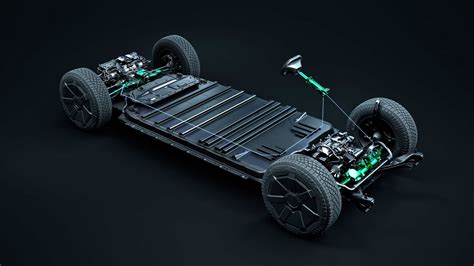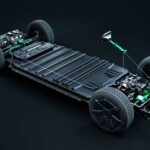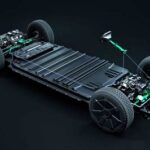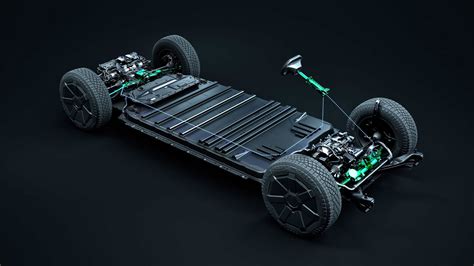
A Chinese electric vehicle (EV) startup, HiPhi, is challenging Tesla’s Cybertruck with its new vehicle, set to launch at approximately $41,000, boasting features like steer-by-wire technology, an adaptive chassis, and rear-wheel steering, along with advanced automated driving capabilities. The vehicle also includes a refrigerator, an unexpected addition to the tech-heavy features.
HiPhi, an electric vehicle marque of Human Horizons, is poised to introduce a formidable competitor to Tesla’s Cybertruck in the burgeoning EV market. Positioned as a direct rival, HiPhi’s new offering comes with a price tag of around $41,000, significantly undercutting Tesla’s much-anticipated model. This competitive pricing, coupled with a suite of advanced technological features, could potentially disrupt the existing EV landscape and attract a wide range of consumers.
One of the key highlights of HiPhi’s vehicle is its integration of steer-by-wire technology. Unlike traditional steering systems that rely on a mechanical linkage between the steering wheel and the wheels, steer-by-wire systems use electronic sensors and actuators to control the vehicle’s direction. This technology offers several advantages, including improved precision, enhanced responsiveness, and greater flexibility in vehicle design. It also allows for the implementation of advanced driver-assistance systems (ADAS) and autonomous driving features, as the steering can be controlled electronically by the vehicle’s computer.
In addition to steer-by-wire, HiPhi’s vehicle features an adaptive chassis. An adaptive chassis is a sophisticated suspension system that automatically adjusts to changing road conditions and driving dynamics. It uses sensors to monitor factors such as vehicle speed, steering angle, and road surface irregularities, and then adjusts the suspension settings accordingly. This results in a smoother, more comfortable ride, as well as improved handling and stability. Adaptive chassis systems can also enhance safety by helping to maintain optimal tire contact with the road, even in challenging driving situations.
Furthermore, the vehicle is equipped with rear-wheel steering, a feature that enhances maneuverability and stability, particularly at low and high speeds. At low speeds, the rear wheels turn in the opposite direction to the front wheels, reducing the turning radius and making it easier to navigate tight spaces. At high speeds, the rear wheels turn in the same direction as the front wheels, improving stability and reducing the risk of skidding. Rear-wheel steering is commonly found in high-performance vehicles and luxury cars, and its inclusion in HiPhi’s vehicle underscores its commitment to providing a technologically advanced driving experience.
However, the inclusion of a refrigerator has raised eyebrows. While unusual for a vehicle in this class, it signals a focus on comfort and convenience, setting it apart from competitors focused purely on performance or utility. The integration of a refrigerator into an EV suggests a design philosophy that prioritizes the overall user experience, catering to drivers who value convenience and comfort on the road.
Technological Advancements and Features
HiPhi’s vehicle boasts several cutting-edge technologies that set it apart from its competitors. The steer-by-wire system is a notable advancement, as it eliminates the mechanical connection between the steering wheel and the wheels. This system uses electronic sensors to detect the driver’s steering input and then transmits this information to actuators that control the wheels. The result is a more precise and responsive steering experience, as well as greater flexibility in vehicle design.
The adaptive chassis is another key feature that contributes to the vehicle’s superior handling and ride comfort. This system uses sensors to monitor various parameters, such as vehicle speed, steering angle, and road surface conditions, and then adjusts the suspension settings accordingly. This allows the vehicle to adapt to different driving conditions in real-time, providing a smooth and stable ride, regardless of the road surface.
Rear-wheel steering further enhances the vehicle’s maneuverability and stability. At low speeds, the rear wheels turn in the opposite direction to the front wheels, reducing the turning radius and making it easier to navigate tight spaces. At high speeds, the rear wheels turn in the same direction as the front wheels, improving stability and reducing the risk of skidding.
The automated driving capabilities are also a major selling point. HiPhi has not yet released detailed information about the specific level of automation offered, but it is likely to include features such as adaptive cruise control, lane keeping assist, and automatic emergency braking. These features can help to reduce driver fatigue and improve safety, making the vehicle a more appealing option for long-distance driving.
The Refrigerator: A Unique Selling Point
The inclusion of a refrigerator in HiPhi’s vehicle is an unexpected but potentially appealing feature. While it may seem like a minor addition, it demonstrates a focus on user comfort and convenience. The refrigerator could be used to keep drinks and snacks cold on long trips, or to store perishable items such as medication or baby food. This feature could be particularly appealing to families and individuals who spend a lot of time on the road.
The integration of a refrigerator into an EV is not entirely unprecedented. Some luxury SUVs and vans offer built-in refrigerators as an optional feature. However, it is relatively rare to see this feature in a vehicle that is priced at around $41,000. This suggests that HiPhi is trying to differentiate itself from its competitors by offering a unique combination of advanced technology and user-friendly features.
Competitive Landscape
HiPhi’s new vehicle is entering a crowded and competitive market. Tesla’s Cybertruck is a major player in the electric pickup truck segment, and other automakers, such as Ford and Rivian, are also offering compelling EV options. To succeed, HiPhi will need to offer a product that is both technologically advanced and competitively priced.
The company’s decision to price its vehicle at around $41,000 is a strategic move. This price point is significantly lower than the expected price of the Cybertruck, which could make HiPhi’s vehicle more appealing to budget-conscious buyers. However, HiPhi will also need to convince consumers that its vehicle is just as capable and reliable as its competitors.
One of the key challenges for HiPhi will be establishing its brand in the global market. The company is relatively new, and it does not have the same brand recognition as established automakers such as Tesla and Ford. To overcome this challenge, HiPhi will need to invest heavily in marketing and public relations. It will also need to build a strong reputation for quality and reliability.
Market Impact and Future Prospects
The introduction of HiPhi’s vehicle is likely to have a significant impact on the EV market. The company’s competitive pricing and advanced technology could put pressure on other automakers to lower their prices and improve their products. This could ultimately benefit consumers, as they will have more choices and more affordable options.
The success of HiPhi’s vehicle will depend on a number of factors, including its ability to deliver on its promises, its ability to build a strong brand, and its ability to navigate the complex regulatory environment in different countries. However, the company has a strong foundation, and it is well-positioned to compete in the rapidly growing EV market.
The steer-by-wire technology, adaptive chassis, rear-wheel steering, and automated driving capabilities all contribute to a compelling package. The inclusion of a refrigerator, while unusual, adds a unique touch that could appeal to certain buyers. If HiPhi can successfully execute its strategy, it has the potential to become a major player in the global EV market.
Detailed Analysis of Key Features
-
Steer-by-Wire Technology: This system replaces the traditional mechanical linkage between the steering wheel and the wheels with an electronic system. Sensors detect the driver’s steering input and send signals to actuators that control the wheels. This offers several benefits, including:
- Improved Precision: The electronic system can provide more precise control over the steering angle, resulting in sharper handling and a more responsive driving experience.
- Enhanced Responsiveness: The electronic system can react more quickly to changes in driving conditions, providing a more immediate and direct response to the driver’s inputs.
- Greater Flexibility in Vehicle Design: The absence of a mechanical linkage allows for more flexibility in the design of the vehicle’s front end, which can improve aerodynamics and packaging.
- Integration with ADAS: Steer-by-wire systems are essential for advanced driver-assistance systems (ADAS) and autonomous driving features, as they allow the vehicle’s computer to control the steering.
-
Adaptive Chassis: This system automatically adjusts the suspension settings to adapt to changing road conditions and driving dynamics. Sensors monitor various parameters, such as vehicle speed, steering angle, and road surface conditions, and then adjust the dampers, springs, and other suspension components accordingly. This offers several benefits, including:
- Improved Ride Comfort: The adaptive suspension can smooth out bumps and irregularities in the road surface, providing a more comfortable ride for passengers.
- Enhanced Handling: The adaptive suspension can optimize the vehicle’s handling by adjusting the suspension settings to match the driving conditions. This can improve grip, stability, and cornering performance.
- Increased Safety: The adaptive suspension can help to maintain optimal tire contact with the road, even in challenging driving situations. This can improve braking performance and reduce the risk of skidding.
- Customizable Driving Modes: Adaptive chassis systems often allow drivers to select different driving modes, such as comfort, sport, or eco. Each mode adjusts the suspension settings to provide a different driving experience.
-
Rear-Wheel Steering: This system allows the rear wheels to turn slightly, either in the same direction as the front wheels (for high-speed stability) or in the opposite direction (for low-speed maneuverability). This offers several benefits, including:
- Reduced Turning Radius: At low speeds, the rear wheels turn in the opposite direction to the front wheels, reducing the turning radius and making it easier to navigate tight spaces.
- Improved Stability: At high speeds, the rear wheels turn in the same direction as the front wheels, improving stability and reducing the risk of skidding.
- Enhanced Agility: Rear-wheel steering can make the vehicle feel more agile and responsive, especially in corners.
- Easier Parking: The reduced turning radius can make parking easier, especially in tight spots.
-
Automated Driving Capabilities: While the specific level of automation offered by HiPhi’s vehicle is not yet known, it is likely to include features such as:
- Adaptive Cruise Control (ACC): ACC automatically maintains a set distance from the vehicle in front, adjusting the vehicle’s speed as needed.
- Lane Keeping Assist (LKA): LKA helps to keep the vehicle centered in its lane by providing gentle steering corrections.
- Automatic Emergency Braking (AEB): AEB automatically applies the brakes if it detects an imminent collision.
- Traffic Jam Assist: This system combines ACC and LKA to provide automated driving assistance in stop-and-go traffic.
- Highway Assist: This system provides automated driving assistance on highways, including lane changes and overtaking maneuvers.
-
Refrigerator: The inclusion of a refrigerator in HiPhi’s vehicle is a unique feature that sets it apart from its competitors. While it may seem like a minor addition, it demonstrates a focus on user comfort and convenience. The refrigerator could be used to keep drinks and snacks cold on long trips, or to store perishable items such as medication or baby food. This feature could be particularly appealing to families and individuals who spend a lot of time on the road. The design and capacity of the refrigerator are not yet known, but it is likely to be a compact unit that is integrated into the vehicle’s interior.
Geopolitical and Economic Implications
The emergence of HiPhi as a competitor to Tesla and other established EV manufacturers has significant geopolitical and economic implications.
- Increased Competition in the EV Market: The entry of Chinese automakers into the global EV market is intensifying competition, which could lead to lower prices and faster innovation. This is good news for consumers, as they will have more choices and more affordable options.
- Shifting Global Power Dynamics: The rise of China as a leader in the EV industry is shifting the global balance of power. China is now the world’s largest market for EVs, and Chinese companies are investing heavily in research and development. This could give China a competitive advantage in the automotive industry for years to come.
- Trade Tensions: The increasing competition between Chinese and Western automakers could lead to trade tensions. Some Western governments may be tempted to impose tariffs or other trade barriers to protect their domestic industries. However, such measures could backfire, as they could also harm consumers and stifle innovation.
- Supply Chain Considerations: The EV industry relies on a complex global supply chain, which includes raw materials, components, and manufacturing facilities. China is a major player in this supply chain, and any disruptions could have a significant impact on the industry.
- Technological Innovation: The competition between Chinese and Western automakers is driving technological innovation in the EV industry. Companies are racing to develop new battery technologies, advanced driver-assistance systems, and other features that will give them a competitive edge.
Challenges and Opportunities for HiPhi
HiPhi faces several challenges as it enters the global EV market:
- Brand Recognition: HiPhi is a relatively new company, and it does not have the same brand recognition as established automakers such as Tesla and Ford. To overcome this challenge, HiPhi will need to invest heavily in marketing and public relations.
- Quality and Reliability: HiPhi will need to convince consumers that its vehicles are just as capable and reliable as those of its competitors. This will require rigorous testing and quality control.
- Regulatory Compliance: HiPhi will need to comply with the complex regulatory environment in different countries. This includes safety standards, emissions regulations, and other requirements.
- Distribution and Service Network: HiPhi will need to establish a distribution and service network to support its customers. This will require significant investment.
Despite these challenges, HiPhi also has several opportunities:
- Growing EV Market: The global EV market is growing rapidly, providing HiPhi with a large and expanding customer base.
- Technological Expertise: HiPhi has a strong team of engineers and designers, and it is committed to developing cutting-edge technologies.
- Competitive Pricing: HiPhi’s vehicle is priced competitively, which could make it appealing to budget-conscious buyers.
- Unique Features: The inclusion of a refrigerator and other unique features could help HiPhi to differentiate itself from its competitors.
Conclusion
HiPhi’s new vehicle represents a significant challenge to Tesla and other established EV manufacturers. Its competitive pricing, advanced technology, and unique features make it a compelling option for consumers. The company faces several challenges as it enters the global market, but it also has several opportunities. If HiPhi can successfully execute its strategy, it has the potential to become a major player in the rapidly growing EV market. The integration of steer-by-wire, adaptive chassis, rear-wheel steering, automated driving features, and even a refrigerator, showcases a comprehensive approach to modern vehicle design, balancing performance, comfort, and convenience. The coming years will be crucial in determining HiPhi’s long-term success and its impact on the broader automotive industry.
Frequently Asked Questions (FAQ)
-
What is the starting price of HiPhi’s Cybertruck rival?
The vehicle is expected to launch at approximately $41,000.
-
What are some of the key technological features of HiPhi’s new vehicle?
Key features include steer-by-wire technology, an adaptive chassis, rear-wheel steering, and advanced automated driving capabilities.
-
What is steer-by-wire technology, and how does it benefit the vehicle?
Steer-by-wire technology replaces the mechanical linkage between the steering wheel and the wheels with an electronic system. This offers improved precision, enhanced responsiveness, greater flexibility in vehicle design, and integration with advanced driver-assistance systems (ADAS).
-
What is unique about HiPhi’s vehicle compared to other electric vehicles in its class?
The inclusion of a refrigerator is a unique feature that sets it apart, demonstrating a focus on user comfort and convenience.
-
Who is HiPhi, and what are their plans for the future in the EV market?
HiPhi is an electric vehicle marque of Human Horizons. They are positioning themselves as a competitor to Tesla and other established EV manufacturers, aiming to offer technologically advanced and competitively priced vehicles in the global EV market. They plan to establish their brand by investing in marketing and public relations, and to maintain their quality and reliability to compete with the leading companies.
- How does the adaptive chassis improve the driving experience?
The adaptive chassis uses sensors to monitor road conditions and driving dynamics, adjusting the suspension in real-time for a smoother, more comfortable ride, improved handling, and enhanced stability. It helps maintain optimal tire contact with the road, even in challenging situations.
- What advantages does rear-wheel steering provide to HiPhi’s vehicle?
Rear-wheel steering enhances maneuverability, especially at low speeds with a reduced turning radius. At high speeds, it improves stability, minimizing skidding risks, which is usually found in luxury or high-performance cars.
- What level of automated driving capabilities can consumers expect from HiPhi’s new vehicle?
Although HiPhi hasn’t provided specific details, one can expect features such as adaptive cruise control, lane keeping assist, and automatic emergency braking to reduce driver fatigue and improve safety.
- Why is the inclusion of a refrigerator considered a unique selling point?
While uncommon in similar vehicles, the inclusion highlights HiPhi’s focus on comfort and convenience. It offers practical utility for storing drinks, snacks, or perishable items during travel, setting it apart from purely performance-focused competitors.
- How might HiPhi’s pricing strategy impact the overall electric vehicle market?
Priced around $41,000, the vehicle is significantly more affordable than Tesla’s Cybertruck, potentially attracting budget-conscious buyers and pressuring competitors to lower prices.
- What are the potential geopolitical implications of HiPhi entering the global EV market?
HiPhi’s entry could intensify competition, impacting global power dynamics by boosting China’s presence in the EV sector, potentially leading to trade tensions as Western nations try to protect their automotive industries.
- What challenges does HiPhi face as a new entrant in the electric vehicle market?
Challenges include building brand recognition, proving quality and reliability, complying with international regulations, and establishing a strong distribution and service network to support global customers.
- What market opportunities does HiPhi have to gain a competitive advantage?
HiPhi can capitalize on the growing EV market, leverage its technological expertise, maintain competitive pricing, and offer unique features like the refrigerator to differentiate itself from competitors.
- How does HiPhi plan to establish its brand in the international electric vehicle market?
HiPhi plans on investing heavily in marketing and public relations, while also focusing on building a strong reputation for quality and reliability to attract consumers and establish itself as a reputable brand.
- What impact will HiPhi have on the speed of innovation and the adoption of new technologies in the automotive industry?
The entry of a new competitor with advanced features like steer-by-wire and an adaptive chassis can encourage faster innovation as established automakers strive to maintain their competitiveness and market share.
- What steps will HiPhi take to ensure the safety and reliability of its steer-by-wire system?
Redundancy in electronic systems, rigorous testing and validation, and adherence to international safety standards are critical steps. Regular software updates and monitoring are also essential for maintaining safety and reliability over time.
- How will the adaptive chassis system be calibrated and tested for different road conditions and driving styles?
Manufacturers typically conduct extensive simulations and real-world testing across diverse environments and driving scenarios. Data collected is then used to calibrate the adaptive chassis control algorithms for optimal performance and driver comfort.
- What are the security measures in place to prevent hacking or unauthorized control of the HiPhi vehicle’s electronic systems?
Modern vehicles incorporate cybersecurity measures such as encrypted communication channels, intrusion detection systems, and secure over-the-air update capabilities. Regular security audits and penetration testing help identify and address vulnerabilities.
- What are the environmental considerations in HiPhi’s vehicle production, including battery sourcing and manufacturing processes?
Sustainable practices include responsible sourcing of battery materials, minimizing waste in manufacturing, reducing energy consumption, and designing batteries for end-of-life recycling or repurposing. Transparency in the supply chain is also crucial.
- How does HiPhi plan to address the charging infrastructure challenges faced by EV owners, especially in regions with limited charging stations?
Partnering with charging network providers, supporting multiple charging standards (CCS, CHAdeMO, etc.), and investing in battery technology that maximizes range are common strategies. Offering home charging solutions and exploring battery swapping technologies can also help.









